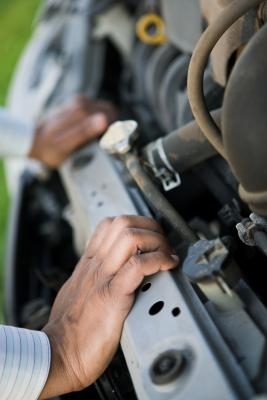
The 1999 Chevrolet Blazer uses a pressurized, fluid-based cooling system. It consists of several components, including the radiator and coolant reservoir. Flushing the radiator and coolant system requires removing the existing fluid, cleaning the interior parts and adding new coolant. Fluid removed from the system is poisonous and should be handled and disposed of carefully. If you didn't flush your coolant at the beginning of last winter, you should at the beginning of this winter.
Find the radiator cap inside the engine compartment. It is at the front and to the left, beside the battery. This cap maintains a constant pressure within the colling system and should never be opened while the engine is hot.
Locate the radiator drain cock. This device is at the bottom of the radiator, on the passenger side. It is a small cylinder that sticks out of the radiator toward the engine. It has a small fitting on the end that you unscrew to allow the coolant to flow. The coolant then travels out through a small tube attached to the drain cock to the bottom of the truck. If this tube is missing, replace it. The tube attaches to a small barb on the bottom of the coolant drain cock.
Look for the coolant reservoir behind the battery. It has a black plastic cap and may have a small amount of coolant inside. This portion of the system is not pressurized and can be opened at any time. This reservoir allows extra coolant inside the radiator to expand into it, and then the excess is automatically sucked back into the radiator as it cools.
Verify that the engine is completely cooled. Place a bucket under the plastic hose attached to the drain cock. Open the drain and allow all of the coolant to exit the radiator. This make take several minutes since the vehicle uses almost three gallons of fluid and the flow rate is very slow. Close the drain cock.
Pour the entire package of radiator detergent into the radiator through the radiator cap. Fill the rest with distilled water. When it is full, wait three minutes and add more water if the level has dropped. The level may drop due to water slowly flowing into other portions of the cooling system. Put the radiator cap back on and tighten.
Crank the truck. Let it run for 15 minutes. This allows the radiator detergent to loosen any deposits within the system. Keep an eye on the temperature gauge inside the truck. Temperature should not exceed 200 degrees F. If the truck begins to overheat, shut the engine off, allow it to cool and add more distilled water to the radiator.
Allow the engine to cool. Drain the water and detergent from the radiator into a bucket. Close the radiator drain cock after the flow stops.
Refill the system with distilled water through the radiator cap. Run the engine for 15 minutes, then let it cool. Drain this plain water into a bucket and close the drain cock. This step ensures that no residual coolant or detergent is left inside the cooling system.
Pour 1 1/2 gallons of high-quality antifreeze/coolant into the radiator. Fill the rest of the way with clean, distilled water. Adding the required amount of coolant first eliminates the need to mix the coolant and water to the required 50% solution and accounts for any water left in the cooling system. Be sure not to add pre-mixed coolant because this will throw off the required concentration.
Replace the radiator cap with a new one. These caps can fail without any outward evidence. A cap that is not maintaining the correct pressure can prevent the cooling system from operating and cause major engine damage. Tighten the cap and check all hoses and surrounding parts for wear. Replace any damaged parts.
Drain the coolant reservoir with a fluid vacuum. Catch all fluid in a bucket. Add a 50/50 mixture of coolant and distilled water to the "cool" line on the side of the reservoir. Put cap back on and tighten.
Check the coolant fluid level often after flushing the system. A good rule is to check one day, one week and one month after the service. Add distilled water when needed.
Discard all fluid from the flush according to local laws. Engine coolant is poisonous and sweet-tasting. Some automotive stores and local landfills have receptacles for disposal.